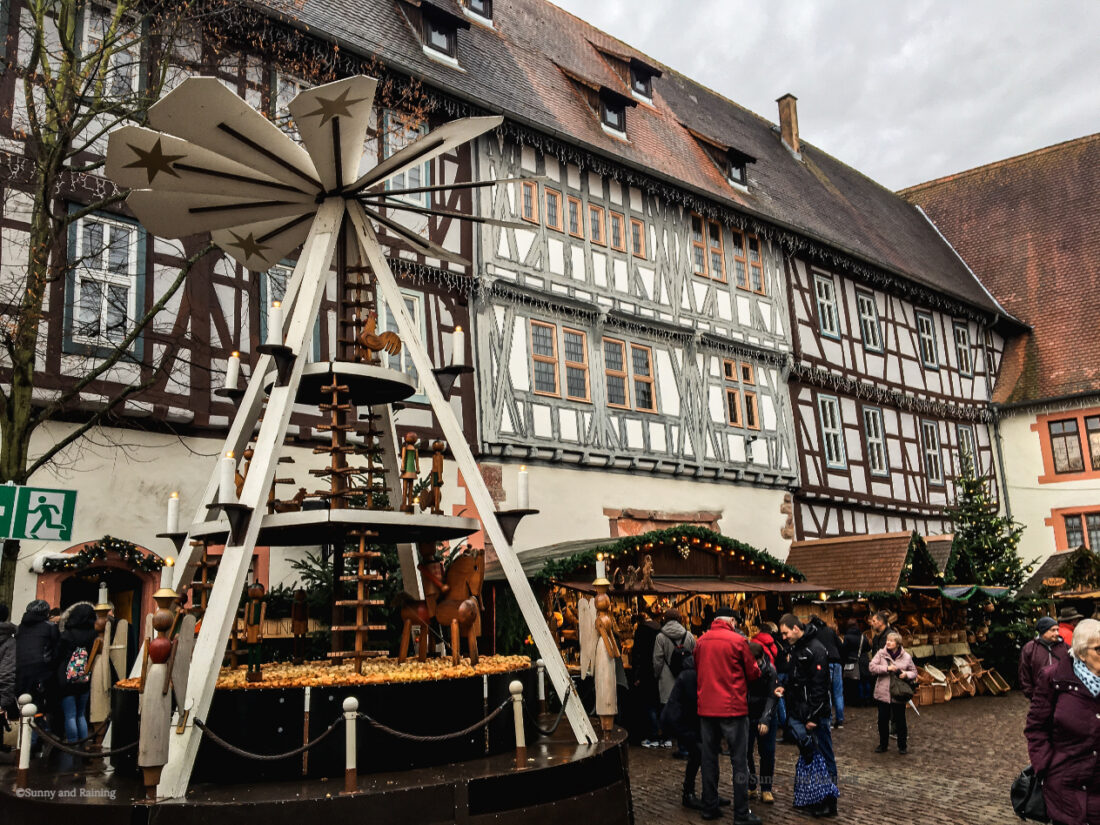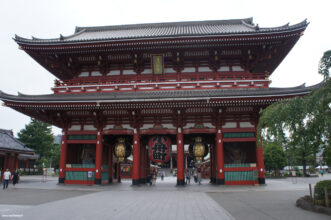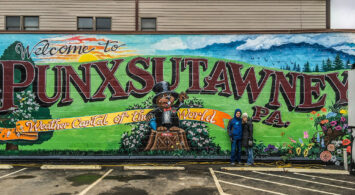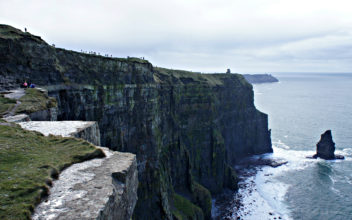T: Rarely do we know exactly which way to go after walking out of a train station for the first time. But it didn’t take long to figure out our destination in Mainz.
Sure, I had a map on my phone, but it was unnecessary. We needed only to follow scores of excited kids and smiling parents to the base of the Mainz Cathedral, which looms over the city and beckons all to the Christkindlmarkt lying beneath it.
E: We were greeted with the sweet smell of Bavarian almonds. Small groups of people gathered around barrels that served as high-top tables. They were eating spätzle and bratwursts and sipping steaming Glühwein out of little glass mugs.
We wandered the small market — charmed by the conversations we couldn’t even understand.
Christmas Markets are magical.
And when those Christmas Markets happen to be in Germany, that magic is just a little bit extra.
. . .
T: A Christkindlmarkt, or Weihnachtsmarkt, occupies the town square of most German towns in December each year. They are a source of pride for many of these towns. The residents pull out all the stops in shaping their city center (often called the Marktplatz) into a festive, charming market for visitors near and far to share in a holiday tradition that, for several towns, dates back to the middle ages.
Mainz was the first of three markets we visited last year in 2019. Mainz, Michelstadt and Frankfurt were each charming and each unique in their own way, but they shared in a limitless love for the joy of Christmas.
E: We had talked for years about wanting to visit a European Christmas Market, and this time we just decided to make it work no matter what. That’s a little easier said than done, considering a lot of other passengers and nonrev travellers tend to have the same ideas. We weren’t picky about which city, or even which country, we’d end up visiting. We just wanted to experience one.
We chose a weekend in December, packed a bag for the weekend and drove to the airport hoping we’d find a way there — wherever “there” was. Open seats to Paris put us on the right continent, and a short flight to Frankfurt had us shaking our heads in disbelief that we actually made it to Germany — our first choice. If we ever had a choice.
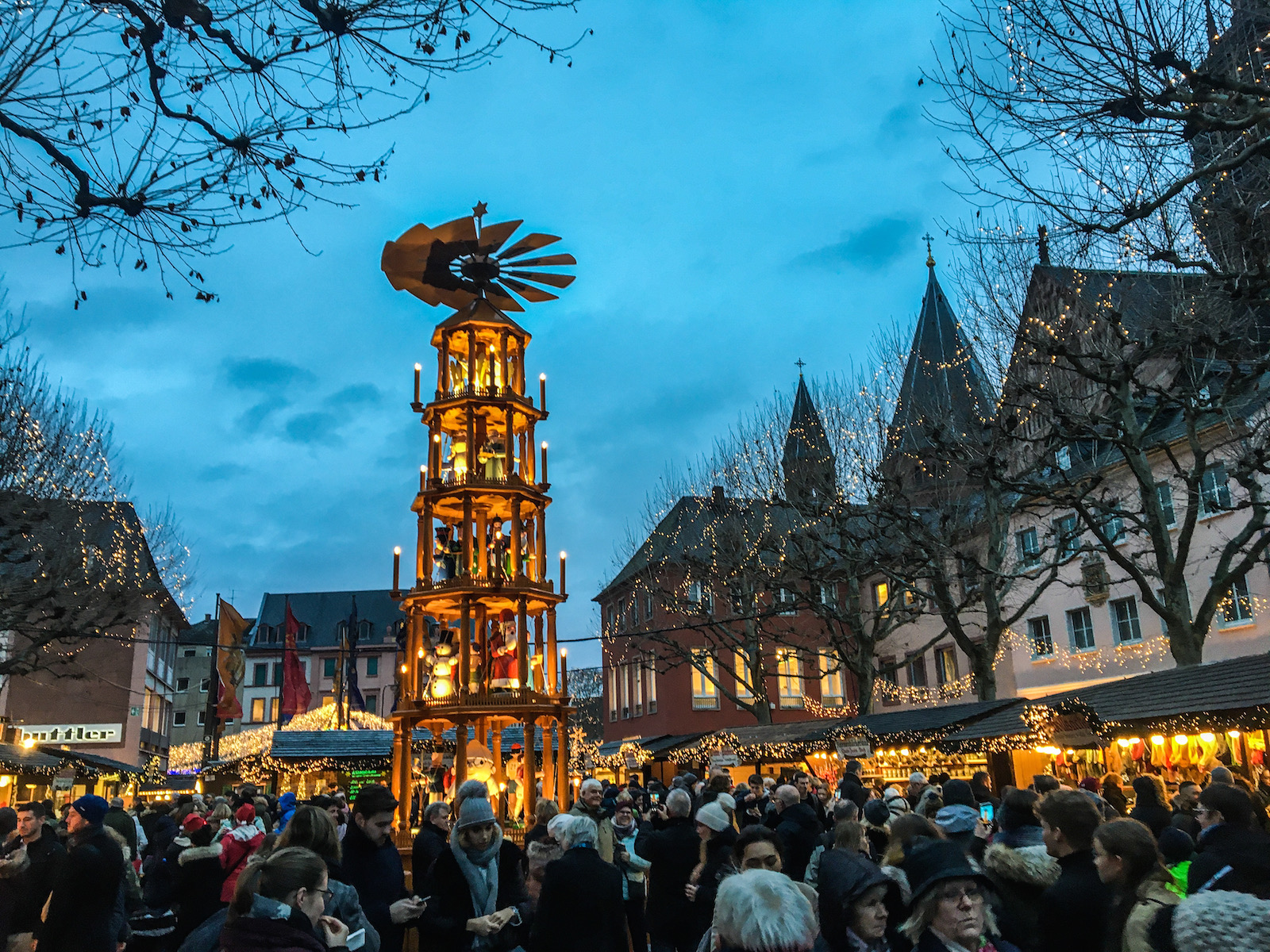
![]() T: The first thing that drew our attention in Mainz is the Christmas pyramid, or in German, the Weihnachtspyramide. The enormous, ornate wooden tower welcomed us like a lighthouse into the waves of people and tiny lights that fan out in all directions. Under this festive canopy, we found aisle after aisle of snacks and handmade gifts. Massive trees and nativity scenes adorned the Marktplatz, and we were even lucky enough to catch carolers echoing their songs from the stage next to the Cathedral.
T: The first thing that drew our attention in Mainz is the Christmas pyramid, or in German, the Weihnachtspyramide. The enormous, ornate wooden tower welcomed us like a lighthouse into the waves of people and tiny lights that fan out in all directions. Under this festive canopy, we found aisle after aisle of snacks and handmade gifts. Massive trees and nativity scenes adorned the Marktplatz, and we were even lucky enough to catch carolers echoing their songs from the stage next to the Cathedral.
It was everything we were hoping for. And we hadn’t even eaten yet.
E: First: kartoffelpuffer. 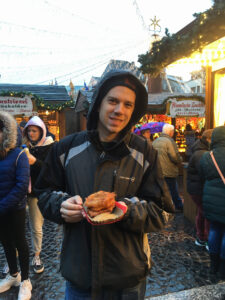
These potato pancakes were everywhere, and they were delicious. Despite Tim not liking applesauce (I know.), I managed to convince him to try the kartoffelpuffer dipped in the traditional applesauce. It sounds weird, but we both enjoyed it.
We also tried a bratwurst — but not like the bratwurst you’d have at a backyard barbeque. This bratwurst was served on a small, warm roll and didn’t even need any condiments. I’d go back to Germany just to try one of those bratwursts again.
We were so entranced with the food that we hardly noticed the cold rain pouring down on us. Small overhangs and cozy little shelters offered a place to stay dry, but we had our sights set on those little glass mugs of Glühwein to help keep us warm. And they did.
 We sipped our Glühwein from the counter of one of the stands. Cheerful conversations filled the air as we watched the workers pour mug after mug of Gluhwein. Others came to the counter with empty glass mugs looking for a refill — or for their deposit back. A mug of Gluhwein was only about £3, and if you return the mug you get £1 back. We decided we’d keep one mug from each market. A perfect souvenir.
We sipped our Glühwein from the counter of one of the stands. Cheerful conversations filled the air as we watched the workers pour mug after mug of Gluhwein. Others came to the counter with empty glass mugs looking for a refill — or for their deposit back. A mug of Gluhwein was only about £3, and if you return the mug you get £1 back. We decided we’d keep one mug from each market. A perfect souvenir.
. . .
E: Daylight lingered for a short while as we wandered through the seemingly endless stalls of treats and gifts. We soaked in the backdrop of Mainz — featuring ancient homes and churches that so beautifully framed the market.
We even made a stop at the Gutenberg Museum just around the corner. For journalism nerds like us, getting to visit this museum was sort of surreal. Johannes Gutenberg invented printing from movable type — the printing press. We saw one of the first original copies of the Bible, learned all we could about the printing press and couldn’t believe all this history was right here in Mainz.
T: After visiting the last few rows of stands, stopping to admire handcarved gifts and resisting the endless supply of fried food and desserts around every corner, it was time to head back to the hotel.
We took the long way back to the Mainz train station. First, we meandered a few blocks north of the market to see St. Christoph’s church, which was bombed by Allied Forces in 1945. It sits now as an empty shell of its former self, allowing visitors a glimpse into what was all too familiar in the World War II era just 75 years ago. It was a sad sight, but an important stop.
We continued on, past another cathedral (I believe it was the Cityseelsorge) with its booming church bells ringing out in the chilly and otherwise quiet winter night.
Finally, after wandering through several smaller markets which dot the streets to give visitors one last glimpse of Christmas joy — and of course, another mug of Glühwein.
. . .
T: Traveling via the local trains in Germany can be somewhat cumbersome, but once the shock wears off from being unable to read your own ticket, it is actually fairly simple.
Having meandered through eastern Germany a few years ago visiting Wittenberg and Eisleben via local trains, we weren’t intimidated. One ticket, which is usually less than £40 or so for an entire family, was all we needed to travel to and from Michelstadt, even from our hotel at the Frankfurt Airport (note: it only includes some of the trains within the Frankfurt city limits, so use caution).
I love the train rides around Germany. One trip through the countryside of rural Germany and it’s abundantly clear why so many Germans moved to southern Minnesota and Wisconsin. The lush, rolling hills throughout Germany match the rolling hills of the river valleys in Minnesota and Wisconsin quite well. Every town is punctuated by a charming, towering church spire. Staring out the windows of the train, I get lost in the ordinary but beautiful history hidden in each small town that passes by.
We reached the station in Michelstadt that next morning and set out down the street toward the market. While Mainz had a bustling, urban feel—as did the Frankfurt market we visited later — the Michelstadt market was the charming, quaint experience we didn’t want to miss.
We managed to beat most of the crowd to Michelstadt, arriving when the streets were still fairly quiet. Michelstadt’s market is centered near the town’s iconic Rathaus, but spills over into tiny, narrow streets and alleys in all directions. Just off the main street, another small plaza housed more shops and nativity scenes, as well as another pyramid.
For a brief while, we basically had the place to ourselves.
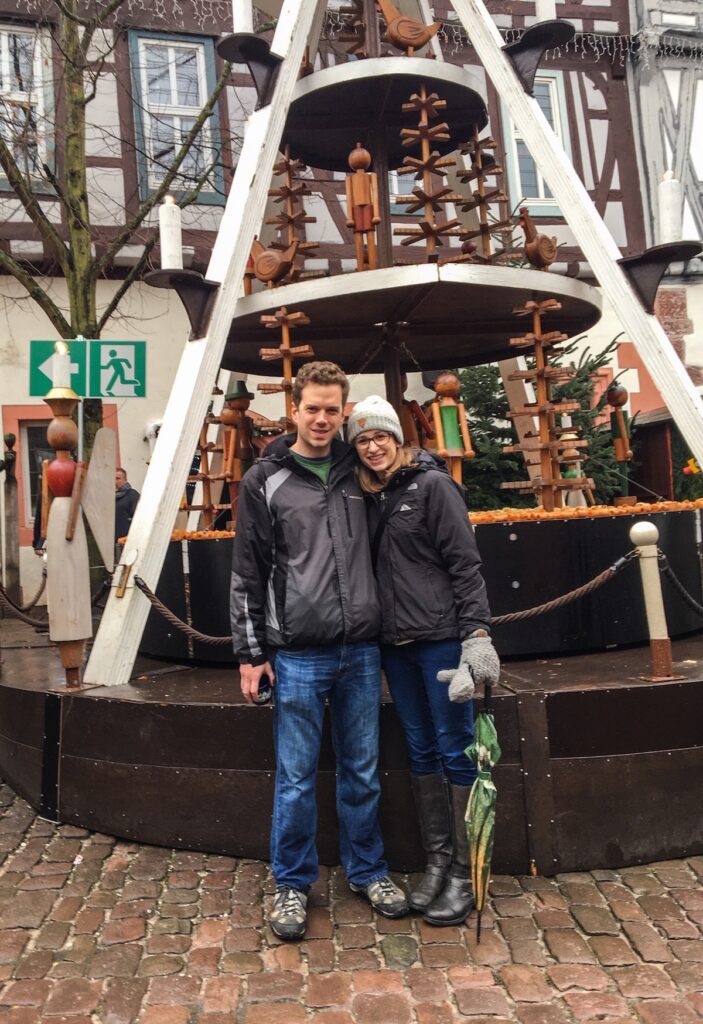
E: You could say that European Christmas Markets all have a similar vibe. They’re cozy. They sell festive foods and gifts. They’re everywhere.
But there was just something about the Christmas market in Michelstadt that immediately captured my heart. We almost didn’t go — not wanting to waste precious time traveling nearly two hours to another market. But it was so worth it.
Michelstadt is a quaint town filled with classic timber-frame homes. Adding a Christmas market to the scene made the village even more mesmerizing.
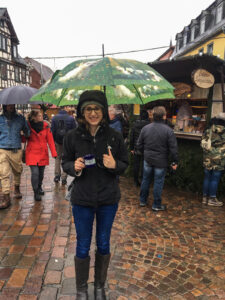 We were greeted with more cold rain, but thankfully a kind stranger offered us an umbrella. We tried to say we’d bring it back when we were done, but the man didn’t mind. He told us to keep it, and we didn’t even care that the umbrella was covered in puppies. It kept us nice and dry throughout the day.
We were greeted with more cold rain, but thankfully a kind stranger offered us an umbrella. We tried to say we’d bring it back when we were done, but the man didn’t mind. He told us to keep it, and we didn’t even care that the umbrella was covered in puppies. It kept us nice and dry throughout the day.
We spent the afternoon wandering the market, and the best part was turning a corner and seeing the most beautiful giant Christmas pyramid. I didn’t want to leave, so I think we stood there for a good long while and soaked in a vibe I never wanted to forget.
The food was also a highlight in Michelstadt. We tried more kartoffelpuffer and schnitzel, and walked around town with our little mugs of Glühwein.
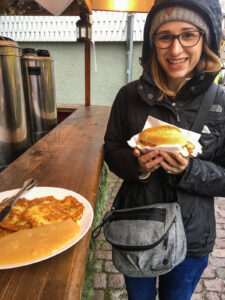
One of my favorite things about German Christmas Markets is how everyone seemed to embrace the outdoors. It didn’t matter if it was cold or rainy — people just walked around and didn’t let it faze them. That’s a mindset I think we could all embrace. The weather shouldn’t dictate our happiness or what we’re able to do. We can just embrace whatever season we’re in and find cozy little ways to enjoy it.
T: As we circled the town, finishing our Glühwein and kartoffelpuffer and admiring the lights and architecture, we found ourselves back in front of the Rathaus. A crowd had gathered around a small brass band playing Christmas carols.
We happily parked ourselves in the midst of the crowd to take in a few tunes. We quickly found ourselves recognizing just about every one, from “O Christmas Tree” to “Joy to the World” and everything in between. It was all we could do to not join in with the English words, which would have undoubtedly clashed with those around us who were singing in German.
As the band played “Tochter Zion, freue dich,” a German carol from whose tune we get the hymn “Thine Be the Glory,” I got lost looking around at where we were.
Elizabeth and I stood thousands of miles away from home, in a different language, with nobody we’ve ever seen in our lives — but the beauty and joy of Jesus’ birth rang out plainly in the streets of Michelstadt just as they do at our home church, or at Christmas with our family.
The moment was so ordinary, and yet so overwhelming.
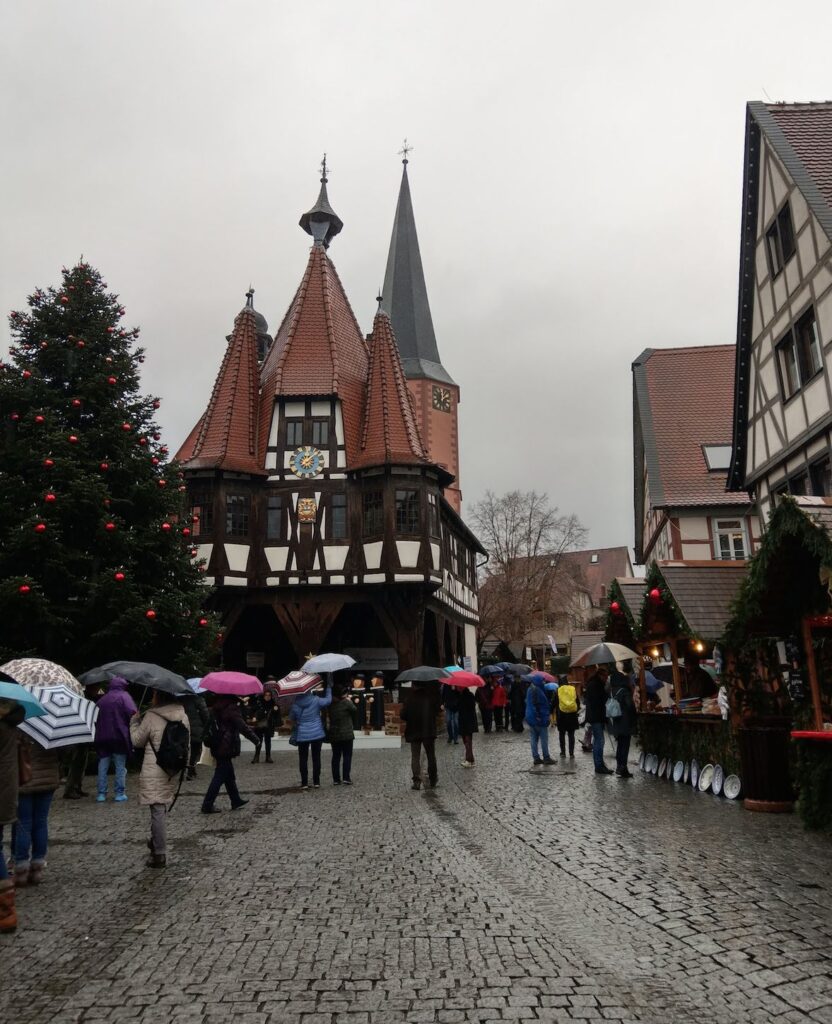
E: True to our style, we really only had this one full day in Germany before we left for home. So that evening, we returned to Frankfurt and decided to take in the city’s sprawling Christmas market before heading back to our hotel.
I’m not sure what I expected, but the market in Frankfurt was quite a spectacle. It’s set in the heart of Old Town and features a giant carousel and hundreds of little stalls, which certainly drew a crowd.
Our walk through the seemingly endless market was fueled by a bratwurst and eventually a Nutella crepe. This whole Christmas Market trip was really about soaking in the vibe, so that’s what we did for a long time in Frankfurt. We got one last mug of Glühwein in a cute little ceramic mug, and stood there people-watching. We talked about how we’d be back to a European Christmas Market one day. Maybe one in Dusseldorf next time. Or Cologne. Or even Estonia.
I was just proud of us for being there — for doing the things we always said we wanted to do, instead of just dreaming of them. One full day in Germany was all we had for this trip, and it was just enough time.
Eventually the lights were starting to go out and the stalls were all starting to close, so we meandered our way toward the train station to get some sleep before our flight home in the morning.
But as we passed a stall with a few warm kartoffelpuffer left over, we couldn’t pass them by. We ordered the last two, and I couldn’t think of a more perfect way to end our European Christmas Market trip.
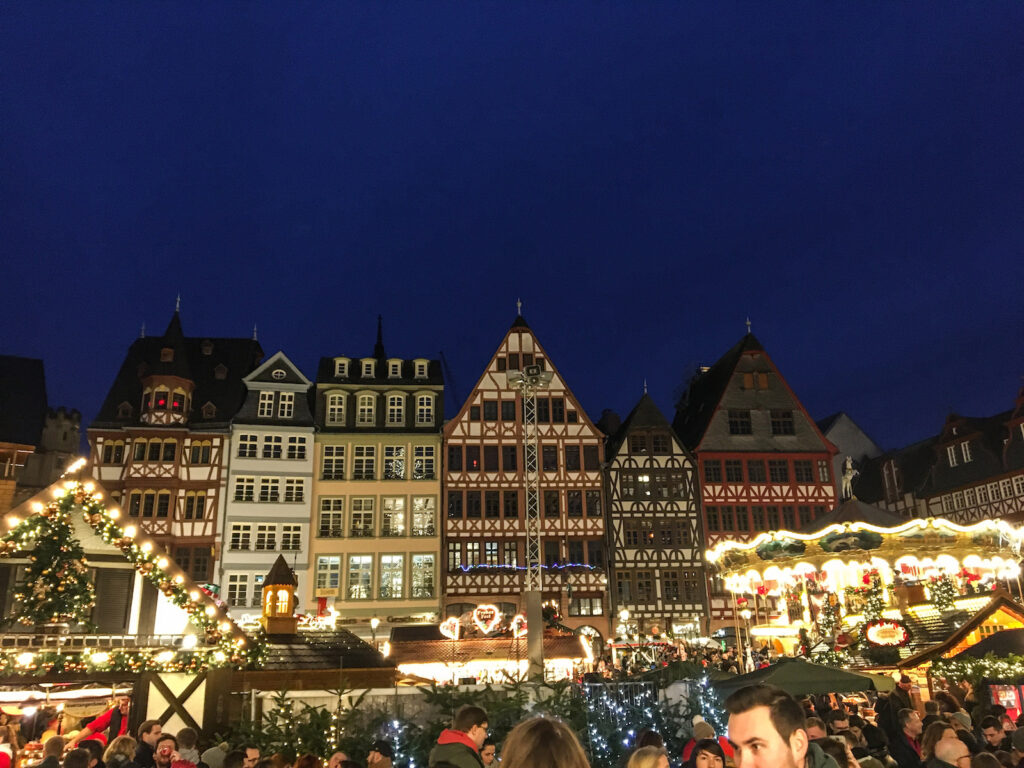
When we went: Mid-December 2019
Where we stayed: Hilton Garden Inn Frankfurt
How long we stayed: Two nights, One and a half days
What we wish we knew before we went: Germany can be quite cold and rainy in December. Bring an umbrella.
